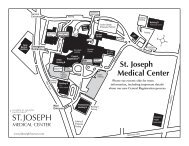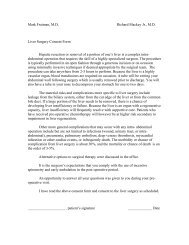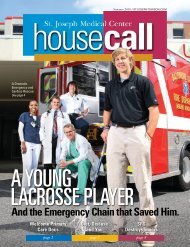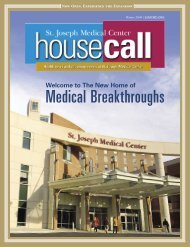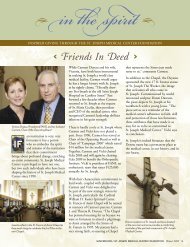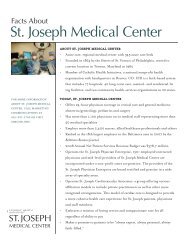Infection Control - St. Joseph Medical Center
Infection Control - St. Joseph Medical Center
Infection Control - St. Joseph Medical Center
Create successful ePaper yourself
Turn your PDF publications into a flip-book with our unique Google optimized e-Paper software.
EMergency Care<br />
Faster ER Care, Thanks<br />
to Auto Industry Methods<br />
Treatment time decreased by 25%<br />
When you rush a family<br />
member to your neighborhood<br />
emergency department, the first<br />
thought that crosses your mind<br />
is how long of a wait you’ll have.<br />
According to Press Ganey Associates,<br />
the average wait in a U.S. emergency<br />
department (ED) is 3.7 hours. And<br />
between 1996 and 2006, 32 percent more<br />
Americans sought ED care. This has led to<br />
a troubling situation—when an ED reaches<br />
capacity, ambulances get diverted away<br />
to distant EDs. To try to ease ED crowding,<br />
many hospitals have scrambled to open<br />
up more beds, but that doesn’t really help,<br />
explained Durenda Juergensen, RN, assistant<br />
vice president of Nursing Operations<br />
at <strong>St</strong>. <strong>Joseph</strong>. “Opening up additional<br />
expensive capacity isn’t the solution.<br />
We need to attack the root cause of the<br />
patient backups in the ED—the length of<br />
time it takes to treat each patient.”<br />
So, <strong>St</strong>. <strong>Joseph</strong> <strong>Medical</strong> <strong>Center</strong> forged<br />
ahead with innovations—and succeeded.<br />
“We’ve had a 25 percent decrease in<br />
length of stay in the ED,” said Dr. Gail<br />
Cunningham, chief of <strong>St</strong>. <strong>Joseph</strong>’s ED.<br />
“The impact has been dramatic. By<br />
reducing our ambulance divert times,<br />
we are accommodating ambulances<br />
and patients better, and have sped up<br />
treatment time. Our yellow ambulance<br />
diverts are down approximately 60 percent<br />
and red diverts (critical care situations)<br />
are down 85 percent.”<br />
The road to success was to utilize<br />
so-called “lean methods” from the auto<br />
industry. To do this, <strong>St</strong>. <strong>Joseph</strong> recruited<br />
an expert from that field; Dave Norton,<br />
nicknamed “The Lean Guy.”<br />
“Lean creates speed, by improving cycle<br />
time, and efficiency, through elimination<br />
of waste. We improved patient flow, eliminated<br />
delays, standardized process steps<br />
to ensure they are done perfectly, and<br />
organized our workplace effectively,” said<br />
Norton. “For example, we improved chest<br />
pain patients’ time from arrival to an EKG<br />
‰ When to go to the ER *<br />
• Chest pain lasting more than<br />
two minutes<br />
• Uncontrolled bleeding<br />
• Severe or sudden pain<br />
• Coughing or vomiting blood<br />
• Difficulty breathing, shortness of breath<br />
• Sudden dizziness, weakness,<br />
change in vision<br />
• Severe/persistent vomiting or diarrhea<br />
• Change in mental status<br />
Do not delay—call 911!<br />
*According to the American College of Emergency Physicians<br />
by 50 percent. Patients get to key treatments<br />
and decision points faster.”<br />
“<strong>St</strong>. <strong>Joseph</strong>’s capabilities are vitally<br />
important to the community’s health.<br />
Being a major provider of emergency<br />
services, including heart and stroke, we<br />
still provide the highest quality of care<br />
—but faster than before,” said Jurgensen.<br />
Lean time-savers include:<br />
• ED zone/room and staff are readied before an ambulance arrives<br />
• Patient moves quickly into triage station where nurse and technician are both located<br />
• A tracking system proactively reports patients’ test and lab data<br />
SJMcmd.org / <strong>St</strong>. <strong>Joseph</strong> <strong>Medical</strong> <strong>Center</strong> Fall 2009




